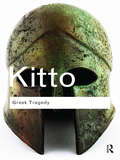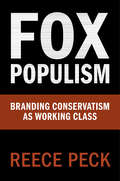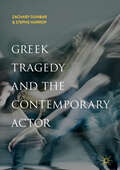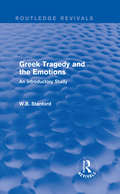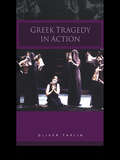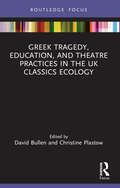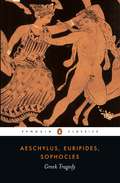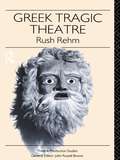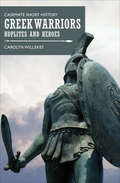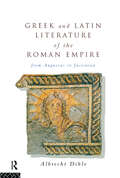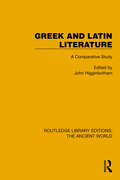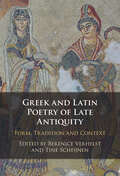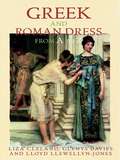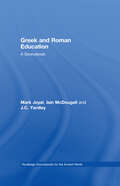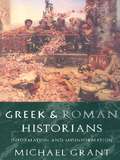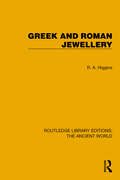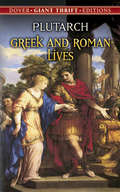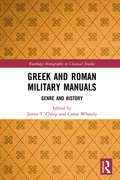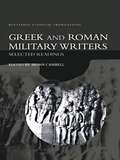- Table View
- List View
Greek Tragedy (Routledge Classics Ser.)
by H. D. KittoThis classic work not only records developments in the form and style of Greek drama, it also analyses the reasons for these changes. It provides illuminating answers to questions that have confronted generations of students, such as:* why did Aeschylus introduce the second actor?* why did Sophocles develop character drawing?* why are some of Euripides' plots so bad and others so good?Greek Tragedy is neither a history nor a handbook, but a penetrating work of criticism which all students of literature will find suggestive and stimulating.
Greek Tragedy (Routledge Classics)
by H.D.F. KittoWhy did Aeschylus characterize differently from Sophocles? Why did Sophocles introduce the third actor? Why did Euripides not make better plots? So asks H.D.F Kitto in his acclaimed study of Greek tragedy, available for the first time in Routledge Classics. Kitto argues that in spite of dealing with big moral and intellectual questions, the Greek dramatist is above all an artist and the key to understanding classical Greek drama is to try and understand the tragic conception of each play. In Kitto&’s words &‘We shall ask what the dramatist is striving to say, not what in fact he does say about this or that.&’ Through a brilliant analysis of Aeschylus&’s &‘Oresteia&’, the plays of Sophocles including &‘Antigone&’ and &‘Oedipus Tyrannus&’; and Euripides&’s &‘Medea&’ and &‘Hecuba&’, Kitto skilfully conveys the enduring artistic and literary brilliance of the Greek dramatists.
Greek Tragedy After the Fifth Century: A Survey from ca. 400 BC to ca. AD 400
by Antonis K. Petrides Vayos LiapisDid Greek tragedy die along with Euripides? This accessible survey demonstrates that this is far from being the case. In it, thirteen eminent specialists offer, for the first time in English, broad coverage of a little-studied but essential part of the history of Greek tragedy. The book contains in-depth discussions of all available textual evidence (including inscriptions and papyri), but also provides historical perspectives on every aspect of the post-fifth-century history of tragedy. Oft-neglected plays, such as Rhesus, Alexandra, and Exagōgē (the only surviving Biblical tragedy), are studied alongside such topics as the expansion of Greek tragedy beyond Athens, theatre performance, music and dance, society and politics, as well as the reception of Greek tragedy in the Second Sophistic and in Late Antiquity, and the importance of ancient scholarship in the transmission of Greek tragic texts.
Greek Tragedy and the Contemporary Actor
by Zachary Dunbar Stephe HarropThis book offers a provocative and groundbreaking re-appraisal of the demands of acting ancient tragedy, informed by cutting-edge scholarship in the fields of actor training, theatre history, and classical reception. Its interdisciplinary reach means that it is uniquely positioned to identify, interrogate, and de-mystify the clichés which cluster around Greek tragedy, giving acting students, teachers, and theatre-makers the chance to access a vital range of current debates, and modelling ways in which an enhanced understanding of this material can serve as the stimulus for new experiments in the studio or rehearsal room. Two theoretical chapters contend that Aristotelian readings of tragedy, especially when combined with elements of Stanislavski’s (early) actor-training practice, can actually prevent actors from interacting productively with ancient plays and practices. The four chapters which follow (Acting Sound, Acting Myth, Acting Space, and Acting Chorus) examine specific challenges in detail, combining historical summaries with a survey of key modern practitioners, and a sequence of practical exercises.
Greek Tragedy and the Emotions: An Introductory Study (Routledge Revivals)
by W. B. StanfordAccording to Aristotle the main purpose of tragedy is the manipulation of emotions, and yet there are relatively few accessible studies of the precise dynamics of emotion in the Athenian theatre. In Greek Tragedy and the Emotions, first published in 1993, W.B. Stanford reviews the evidence for ‘emotionalism’ – as the great Attic playwrights presented it, as the actors and choruses expressed it, and as their audiences reacted to it. Sociological aspects of the issue are considered, and the whole range of emotions, not just ‘pity and fear’, is discussed. The aural, visual and stylistic methods of inciting emotion are analysed, and Aeschylus’ Oresteia is examined exclusively in terms of the emotions that it exploits. Finally, Stanford’s conclusions are contrasted with the accepted theories of tragic ‘catharsis’. Greek terms are transliterated and all quotations are in translation, so Greek Tragedy and the Emotions will appeal particularly to those unfamiliar with Classical Greek.
Greek Tragedy in Action
by Oliver TaplinOliver Taplin's seminal study was revolutionary in drawing out the significance of stage action in Greek tragedy at a time when plays were often read purely as texts, rather than understood as performances.Professor Taplin explores nine plays, including Aeschylus' agamemnon and Sophocles' Oedipus the King. The details of theatrical techniques and stage directions, used by playwrights to highlight key moments, are drawn out and related to the meaning of each play as a whole. With extensive translated quotations, the essential unity of action and speech in Greek tragedy is demonstrated.Now firmly established as a classic text, Greek Tragedy in Action is even more relevant today, when performances of Greek tragedies and plays inspired by them have had such an extraordinary revival around the world.
Greek Tragedy, Education, and Theatre Practices in the UK Classics Ecology (Classics In and Out of the Academy)
by Christine Plastow David BullenThrough a series of case studies, this book explores the interrelations among Greek tragedy, theatre practices, and education in the United Kingdom. This is situated within what the volume proposes as ‘the Classics ecology’.The term ‘ecology’, frequently used in Theatre Studies, understands Classics as a field of cultural production dependent on shared knowledge circulated via formal and informal networks, which operate on the basis of mutually beneficial exchange. Productions of Greek tragedy may be influenced by members of the team studying Classics subjects at school or university, or reading popular works of Classical scholarship, or else by working with an academic consultant. All of these have some degree of connection to academic Classics, albeit filtered through different lenses, creating a network of mutual influence and benefit (the ecology). In this way, theatrical productions of Greek drama may, in the long term, influence Classics as an academic discipline, and certainly contribute to attesting to the relevance of Classics in the modern world. The chapters in this volume include contributions by both theatre makers and academics, whose backgrounds vary between Theatre Studies and Classics. They comprise a variety of case studies and approaches, exploring the dissemination of knowledge about the ancient world through projects that engage with Greek tragedy, theories and practices of theatre making through the chorus, and practical relationships between scholars and theatre makers. By understanding the staging of Greek tragedy in the United Kingdom today as being part of the Classics ecology, the book examines practices and processes as key areas in which the value of engaging with the ancient past is (re)negotiated.This book is primarily suitable for students and scholars working in Classical Reception and Theatre Studies who are interested in the reception history of Greek tragedy and the intersection of the two fields. It is also of use to more general Classics and Theatre Studies audiences, especially those engaged with current debates around ‘saving Classics’ and those interested in a structural, systemic approach to the intersection between theatre, culture, and class.
Greek Tragedy: The Persians, The Seven Against Thebes, The Suppliant Maidens, Prometheus Bound (Greek Tragedy In New Translations Ser.)
by Sophocles Aeschylus EuripidesAgememnon is the first part of the Aeschylus's Orestian trilogy in which the leader of the Greek army returns from the Trojan war to be murdered by his treacherous wife Clytemnestra. In Sophocles' Oedipus Rex the king sets out to uncover the cause of the plague that has struck his city, only to disover the devastating truth about his relationship with his mother and his father.Medea is the terrible story of a woman's bloody revenge on her adulterous husband through the murder of her own children.
Greek Tragic Theatre (Understanding the Ancient World)
by Rush RehmEmphasizing the political nature of Greek tragedy, as theatre of, by and for the polis, Rush Rehm characterizes Athens as a performance culture; one in which the theatre stood alongside other public forums as a place to confront matters of import. In treating the various social, religious and practical aspects of tragic production, he shows how these elements promoted a vision of the theatre as integral to the life of the city - a theatre focussed on the audience.
Greek Vase-painting and the Origins of Visual Humour
by Alexandre G. MitchellA comprehensive study of visual humour in ancient Greece, with special emphasis on works created in Athens and Boeotia. Alexandre Mitchell brings an interdisciplinary approach to this topic, combining theories and methods of art history, archaeology, and classics with the anthropology of humour, and thereby establishing new ways of looking at art and visual humour in particular. Understanding what visual humour was to the ancients and how it functioned as a tool of social cohesion is only one facet of this study. Mitchell also focuses on the social truths that his study of humour unveils: democracy and freedom of expression, politics and religion, Greek vases and trends in fashion, market-driven production, proper and improper behaviour, popular versus elite culture, carnival in situ, and the place of women, foreigners, workers, and labourers within the Greek city.
Greek Warfare beyond the Polis: Defense, Strategy, and the Making of Ancient Federal States
by David A. BlomeGreek Warfare beyond the Polis assesses the nature and broader significance of warfare in the mountains of classical Greece. Based on detailed reconstructions of four unconventional military encounters, David A. Blome argues that the upland Greeks of the classical mainland developed defensive strategies to guard against external aggression. These strategies enabled wide-scale, sophisticated actions in response to invasions, but they did not require the direction of a central, federal government. Blome brings these strategies to the forefront by driving ancient Greek military history and ancient Greek scholarship "beyond the polis" into dialogue with each other. As he contends, beyond-the-polis scholarship has done much to expand and refine our understanding of the ancient Greek world, but it has overemphasized the importance of political institutions in emergent federal states and has yet to treat warfare involving upland Greeks systematically or in depth. In contrast, Greek Warfare beyond the Polis scrutinizes the sociopolitical roots of warfare from beyond the polis, which are often neglected in military histories of the Greek city-state.By focusing on the significance of warfare vis-à-vis the sociopolitical development of upland polities, Blome shows that although the more powerful states of the classical Greek world were dismissive or ignorant of the military capabilities of upland Greeks, the reverse was not the case. The Phocians, Aetolians, Acarnanians, and Arcadians in circa 490–362 BCE were well aware of the arrogant attitudes of their aggressive neighbors, and as highly efficient political entities, they exploited these attitudes to great effect.
Greek Warriors: Hoplites and Heroes (Casemate Short History)
by Carolyn WillekesA concise, enlightening portrait of the men who fought in the ancient battles we still study today. Thermopylae. Marathon. Though fought 2,500 years ago in ancient Greece, the names of these battles are more familiar to many than battles fought in the last half-century. But our concept of the men who fought in these battles may be more a product of Hollywood than Greece. Shaped by the landscape in which they fought, the warriors of ancient Greece were mainly heavy infantry. While Bronze Age Greeks fought as individuals, for personal glory, the soldiers of the classical city-states fought as hoplites, armed with long spears and large shields, in an organized formation called the phalanx. As well as fighting among themselves, as in the notable thirty-year Peloponnesian War between Athens and Sparta immortalized by Thucydides, the city-states came together to fight outside threats. The Persian Wars lasted nearly half a century and saw the Greek armies come together to fend off several massive Persian forces, both on land and at sea. This book sketches the change from heroic to hoplite warfare, and discusses the equipment and training of both the citizen soldiers of most Greek cities and the professional soldiers of Sparta.
Greek and Latin Literature of the Roman Empire: From Augustus to Justinian
by Albrecht DihleProfessor Dihle sees the Greek and Latin literature between the 1st century B.C. and the 6th century A.D. as an organic progression. He builds on Schlegel's observation that art, customs and political life in classical antiquity are inextricably entwined and therefore should not be examined separately. Dihle does not simply consider narrowly defined `literature', but all works of cultural socio-historical significance, including Jewish and Christian literature, philosophy and science. Despite this, major authors like Seneca, Tacitus and Plotinus are considered individually. This work is an authoritative yet personal presentation of seven hundred years of literature.
Greek and Latin Literature: A Comparative Study (Routledge Library Editions: The Ancient World)
by John HigginbothamGreek and Latin Literature (1969) examines the two ancient literatures using a comparative method that recognizes the links between them – most Latin genres owe something to their Greek forebears. How far was Virgil influenced by Homer, Cicero by Demosthenes, Horace by Sappho and Alcaeus? How far did their techniques differ? How far did they share the same interests? Each contributor to this volume aims to answer such questions.
Greek and Latin Poetry of Late Antiquity: Form, Tradition, and Context
by Berenice Verhelst Tine ScheijnenAlthough Greek and Latin poetry from late antiquity each poses similar questions and problems, a real dialogue between scholars on both sides is even now conspicuously absent. A lack of evidence impedes discussion of whether there was direct interaction between the two language traditions. This volume, however, starts from the premise that direct interaction should never be a prerequisite for a meaningful comparative and contextualising analysis of both late antique poetic traditions. A team of leading and emerging scholars sheds new light on literary developments that can be or have been regarded as typical of the period and on the poetic and aesthetic ideals that affected individual works, which are both classicizing and 'un-classical' in similar and diverging ways. This innovative exploration of the possibilities created by a bilingual focus should stimulate further explorations in future research.
Greek and Roman Aesthetics
by Oleg V. Bychkov Anne SheppardThis anthology of philosophical texts by Greek and Roman authors brings together works from the late fifth century BC to the sixth century AD that comment on major aesthetic issues such as the perception of beauty and harmony in music and the visual arts, structure and style in literature, and aesthetic judgement. It includes important texts by Plato and Aristotle on the status and the role of the arts in society and in education, and Longinus' reflections on the sublime in literature, in addition to less well-known writings by Philodemus, Cicero, Seneca, Plotinus, Augustine and Proclus. Most of the texts have been newly translated for this volume, and some are available in English for the first time. A detailed introduction traces the development of classical aesthetics from its roots in Platonism and Aristotelianism to its ultimate form in late Antiquity.
Greek and Roman Animal Sacrifice
by F. S. Naiden Christopher A. FaraoneThe interpretation of animal sacrifice, now considered the most important ancient Greek and Roman religious ritual, has long been dominated by the views of Walter Burkert, the late J.-P. Vernant, and Marcel Detienne. No penetrating and general critique of their views has appeared and, in particular, no critique of the application of these views to Roman religion. Nor has any critique dealt with the use of literary and visual sources by these writers. This book, a collection of essays by leading scholars, incorporates all these subjects and provides a theoretical background for the study of animal sacrifice in an ancient context.
Greek and Roman Dress from A to Z (The Ancient World from A to Z)
by Lloyd Llewellyn-Jones Glenys DaviesFirst Published in 2008. Routledge is an imprint of Taylor & Francis, an informa company.
Greek and Roman Education: A Sourcebook (Routledge Sourcebooks for the Ancient World)
by Mark Joyal J.C Yardley Iain McDougallModern western education finds its origins in the practices, systems and schools of the ancient Greeks and Romans. It is in the field of education, in fact, that classical antiquity has exerted one of its clearest influences on the modern world. Yet the story of Greek and Roman education, extending from the eighth century B.C. into the Middle Ages, is familiar in its details only to relatively few specialists. Containing nearly 300 translated texts and documents, Greek and Roman Education: A Sourcebook is the first book to provide readers with a large, diverse and representative sample of the primary evidence for ancient Greek and Roman education. A special feature of this Sourcebook is the inclusion not only of the fundamental texts for the study of the subject, but also unfamiliar sources that are of great interest but are not easily accessible, including inscriptions on stone and Greek papyri from Egypt. Introductions to each chapter and to each selection provide the guidance which readers need to set the historical periods, themes and topics into meaningful contexts. Fully illustrated and including extensive suggestions for further reading, together with an index of passages explored, students will have no further need for any other sourcebook on Greek and Roman education.
Greek and Roman Gold and Silver Plate (Routledge Library Editions: The Ancient World)
by D.E. StrongGreek and Roman Gold and Silver Plate (1966) examines the history of ancient plate in the period from the Bronze Age to the fifth century A.D. It describes in detail the development of gold and silver plate throughout this long period, and looks at the civilizations where this complicated craft flourished.
Greek and Roman Historians: Information and Misinformation
by Michael GrantIt is today widely accepted that we do not get the whole truth from any historian. Greek and Roman Historians considers the work of ancient historians such as Herotudus, Tacitus and Thucydides in the the light of this attitude. In an enlightening new study, Michael Grant argues that misinformation, even deliberate disinformation, is abundant in their writings.Grant, one of the world's greatest writers of ancient history, suggests new ways of reading and interpreting the ancient historians which maximise their usefulness as source material. He demonstrates how the evidence they provide can be augmented by the use of other, literary and non-literary, sources.Greek and Roman Historians shows us how we can use written history to learn about the ancient world, even if our conclusions are not those its historians intended. The author argues that their work remains our most important source of information, once we have learned to question and incorporate their imperfect regard for the truth.Grant's account is an indispensible guide to the sources and their interpretation for all students of ancient history.
Greek and Roman Jewellery (Routledge Library Editions: The Ancient World)
by R.A. HigginsGreek and Roman Jewellery (1961) covers jewellery from the Classical lands from the early Bronze Age to the late Roman period, almost 3,000 years of continuous development and innovation in the craft. A full account of the technical methods of making jewellery is followed by a description, period by period, of the jewellery itself.
Greek and Roman Lives
by John Dryden Arthur Hugh Clough PlutarchWritten early in the second century, Plutarch's Lives offers richly detailed and anecdotal biographies of some of the ancient world's mightiest and most influential figures. Plutarch sought to explore the characters and personalities of great men, to see how individual natures led ultimately to tragedy or victory. This selection from Plutarch's massive work profiles five Greeks and five Romans. The translation used here is by an unknown writer, but was associated with John Dryden's name because it was originally published in 1683-1686, in conjunction with a life of Plutarch by Dryden. In 1864, it was revised by the poet and scholar Arthur Hugh Clough, whose introduction and notes are also featured. The great men profiled here include Solon, the lawmaker of Athens, who fostered the growth of the city's democratic institutions; Pericles, whose legendary eloquence was epitomized by his well-known funeral oration; and Alexander the Great, whose incredible eleven-year journey of conquest extended from his native Macedonia to Egypt and India. Among the Romans are the warrior-statesman Marius, who opposed the ruling aristocracy and opened the army to commoners; Cicero, the famous orator; and Julius Caesar, whose extensive character sketch provided Shakespeare with the material for one of his greatest plays.
Greek and Roman Military Manuals: Genre and History (Routledge Monographs in Classical Studies)
by James T. Chlup; Conor WhatelyThis volume explores the enigmatic primary source known as the ancient military manual. In particular, the volume explores the extent to which these diverse texts constitute a genre (sometimes unsatisfactorily classified as ‘technical literature’), and the degree to which they reflect the practice of warfare. With contributions from a diverse group of scholars, the chapters examine military manuals from early Archaic Greece to the Byzantine period, covering a wide range of topics including readership, siege warfare, mercenaries, defeat, textual history, and religion. Coverage includes most of the major contemporary siege manual writers, including Xenophon, Frontinus, Vegetius, and Maurice. Close examination of these texts serves to reveals the complex ways in which ancient Greeks, Romans, and Byzantines sought to understand better, and impose order upon, the seemingly irrational phenomenon known as war. Providing insight into the multifaceted collection of texts that constituted military manuals, this volume is a key resource for students and scholars of warfare and military literature in the classical and Byzantine periods.
Greek and Roman Military Writers: Selected Readings
by Brian CampbellBrian Campbell has selected and translated a wide range of pieces from the ancient military writers who tell us about the technical aspects of military practice and the management of armies. The pieces cover a fascinating range of topics - battle formations and manoeuvres, different types of troops, the art of generalship, methods for conducting and resisting a siege, the construction of artillery and fortifications, and every kind of ploy used by generals to defeat their opponents. Each piece is annotated with further explanation and context, making this an essential resource for everyone studying the army and warfare in the classical age.

